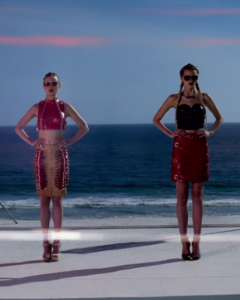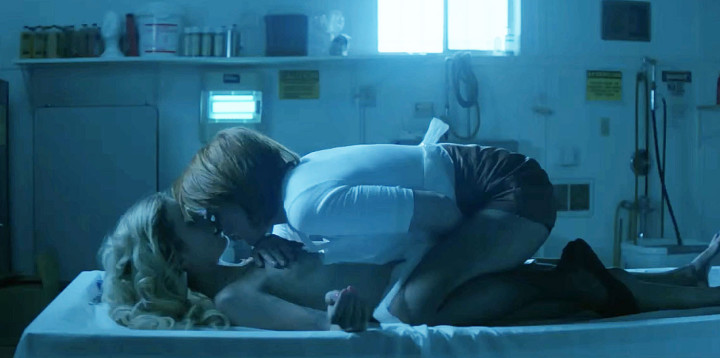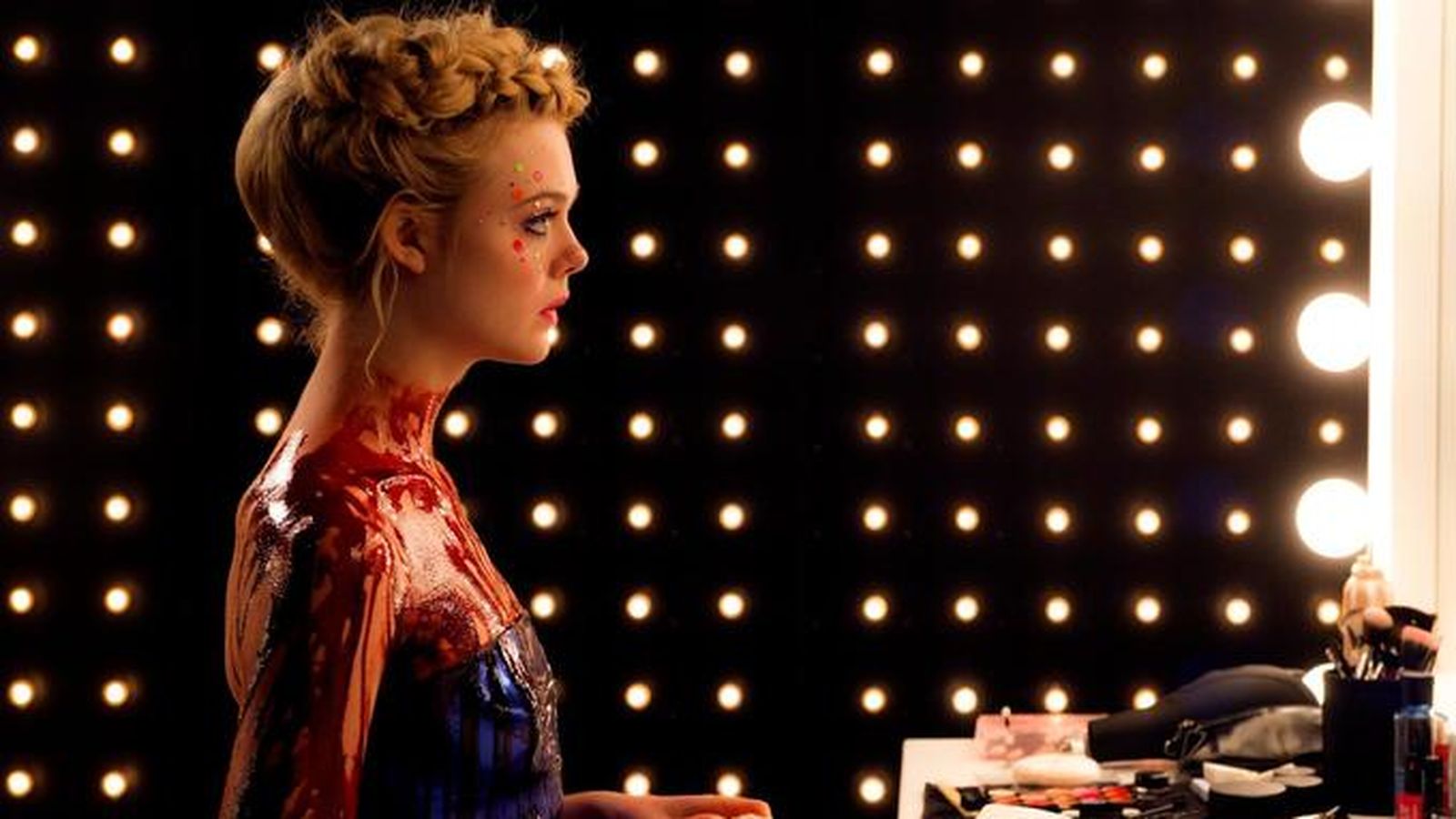Friday Fight Argues over Refn’s THE NEON DEMON

How do you talk about a movie that made your Top 10 of the year by sheer force? The Neon Demon was undoubtedly one of the best movie going experiences I had in 2016, sucking me into its lush world with a dense saturation of neon and lulling me into a trance-like state with one of the year’s best scores, propelling me through dream logic in a way that made me forget to question what kind of sense any of it made. Even if we set aside some of the interesting thematic work that’s bubbling underneath the surface and just focus on the sensory experience that Refn is deftly delivering to us, there’s so much to talk about and dissect. His choices of colors and what they might represent, the flim’s obsession with triangles and what they might mean to and for Elle Fanning’s character, and just what the hell all the wildlife that’s prominently featured throughout has to do with anything. What makes this movie work so well for me, even if I don’t feel like I quite grasp what it’s ultimately getting at, is that even if we start trying to dissect any one of those creative choices, we immediately have to start talking about theme and meaning; metaphor and representation. I know people would like to argue that Refn’s films are just vacuous art projects, but I don’t believe there’s a single choice in this movie that exists in a vacuum.

As an example, the triangles become most prominent in what I would call the “transformation scene.” This is the scene where Fanning is doing an audition of sorts, walking the runway for some prominent fashion elites. She’s been on a journey of discovering the power she holds via her youth and beauty, but it is this scene where she finally decides to wield that power. She transforms from an innocent into the titular Neon Demon as she becomes intoxicated with herself and her ability to control the room. This is all shown to us through a series of gorgeous, highly conceptual images of neon triangles within triangles, representing layers of depth that go beyond the mere surface beauty, but reconvene on one another in a way that the surface beauty becomes representative of the complexity that lies within. We might also say that the triangle is a representation of her transformation itself, with two base points, one representing the person she thought she was and one representing the person she now realizes others see her to be, both versions of herself that can readily be taken advantage of, and a pinnacle representing the convergence of those two self-images into an actualized self that has agency and power.

Now, is this an accurate reading of this scene? I have no idea. And for some, that lack of cohesion between the imagery and the plot of the film itself might be a big problem. But for me, it’s precisely why I think it’s one of 2016’s great films. It leaves itself open to interpretation, and is too provocative not to start a conversation upon the rolling of the credits.
As one last side note, the Farsighted gang and I were all discussing (arguing) about this film last week, and I made a big, bold statement that the film is begging us to look at it through the lens of gender norms and gender politics. And now here I am, not even touching on that concept, as I try to argue in favor of this wonderfully strange film. I bring this up to say
1) I still think that’s an important lens to view this movie through. Fanning’s first photo shoot in LA is the best representation of the male gaze I’ve ever seen on screen. It’s so uncomfortable and disgusting and disconcerting and makes you fear for Fanning’s safety – if that’s not a perfect representation of how one must feel on the receiving end of that gaze, I don’t know what is.
And…
2) That’s how interesting and worthwhile this film is – it’s such a layered text that I could spend an hour trying to write a concise introduction about it and end up four paragraphs deep, defending my exclusion of my own ideas, that you the damn reader wouldn’t even know about if I had just chosen to goddamn exclude them!
But that’s the kind of attention and discussion The Neon Demon deserves.
 LUKE TIPTON: I like arthouse. I like grindhouse. I did not like The Neon Demon. It’s basically an arthouse film vamping in horror drag. This wouldn’t necessarily be a bad thing, some of my favorite horror can be accused of the same (here’s looking at you Eyes Without a Face, Don’t Look Now, and Eraserhead). Unfortunately, the film’s satirical element, and its handling themes of gender and power didn’t do it for me either. I found nothing particularly revealing or in its depiction of flat, lifeless female bodies consumed with, and consumed for a horrific, inhumane ideal of Beauty. Or, in other words, I didn’t find Refn’s very male perspective particularly enlightening to the subject. It didn’t resonate with me. So it was a boring horror movie cum arthouse film full of mumbling emotionally suppressed characters, which felt pretentious and a little hollow. Ultimately it was just off-putting.
LUKE TIPTON: I like arthouse. I like grindhouse. I did not like The Neon Demon. It’s basically an arthouse film vamping in horror drag. This wouldn’t necessarily be a bad thing, some of my favorite horror can be accused of the same (here’s looking at you Eyes Without a Face, Don’t Look Now, and Eraserhead). Unfortunately, the film’s satirical element, and its handling themes of gender and power didn’t do it for me either. I found nothing particularly revealing or in its depiction of flat, lifeless female bodies consumed with, and consumed for a horrific, inhumane ideal of Beauty. Or, in other words, I didn’t find Refn’s very male perspective particularly enlightening to the subject. It didn’t resonate with me. So it was a boring horror movie cum arthouse film full of mumbling emotionally suppressed characters, which felt pretentious and a little hollow. Ultimately it was just off-putting.
This was a little surprising to me considering the kinky little headfuck this film was purported to be, not to mention NWR’s penchant for using genre signifiers to evoke specific tones and moods. I’m a big fan of that technique. Nicholas Winding Refn is a provocateur, but provocation alone doesn’t make great cinema. The provocations here – the necrophilia, a dream sequence involving a man forcing a young woman to fellate a knife (Freud!); cannibalism; and a whole lot of bloodshed – didn’t seem to serve much purpose aside from their supposed shock value. Except it wasn’t’ shocking. It was boring.
I’ll admit it had its moments. The scene of panther in Jesse’s hotel room in particular had an ineffable coolness to it; the presence of Keanu Reeves in general. The film looked gorgeous too.
As I was watching it, I got to thinking about Drive, NWR’s 2011 sleeper hit, a film I quite liked. I remembered how Ryan Gosling’s Driver was barely a character at all; just a brooding, Strong Silent Type with a messiah complex, cool car, scorpion jacket (since appropriated by douchebags, but not NWR’s fault), driving gloves and a toothpick lazily hanging from his perfect lips. But I really dug that then. He was an immaculately put together collection of those cool genre signifiers I had mentioned. He’s a little Steve McQueen, a little Alain Delon in Le Samouraï. The flat, empty characters in Neon Demon were just boring to me. And that just depressed me. Was I being sexist? Did I just give Refn’s empty stylishness a pass when it was a cool dude in a cool car? Did I project a depth onto The Driver that wasn’t there because I am trained to do so on male characters? Can I not be bothered to care when NWR applies his immaculate, clinical style to women? Or is it because these empty female characters felt over-familiar because the objectification of women is so pervasive in movies and culture that aren’t written with the same humanity and depth of character that men are? Because women are interchangeable and disposable in cinema?
Now I was really depressed… and Jena Malone started fucking a corpse.

 BLAINE MCLAREN: Nicholas Winding Refn (or NWR, check the title card) has been one of the most interesting Auteurs of the past decade. He won me over immediately with the Pusher films, again with Valhalla Rising and became one of my favorite directors with (the highly underrated) Only God Forgives. When I found out that I was going to see his next film in the multiplex, I lost my shit. I pre-ordered my tickets like it was the hottest show in town and treated it like a holiday.
BLAINE MCLAREN: Nicholas Winding Refn (or NWR, check the title card) has been one of the most interesting Auteurs of the past decade. He won me over immediately with the Pusher films, again with Valhalla Rising and became one of my favorite directors with (the highly underrated) Only God Forgives. When I found out that I was going to see his next film in the multiplex, I lost my shit. I pre-ordered my tickets like it was the hottest show in town and treated it like a holiday.
With all of this pageantry, it was hard for anything to live up to my self-generated hype. I remember sinking into my seat and letting the film just wash over me. The only problem was that I was forcing myself to enjoy the flick. It took me a little time to admit it, but my favorite director had let me down. I expected an intense visual feast, but got a bloated and hamfisted movie that lacked the heart I had come to expect.
Since my first experience I have revisited The Neon Demon a few times and I still don’t love it, but it has mildly grown on me. The visual stylings and performances are impressive, but the whole “Hollywood is going to chew you up and spit you out” cliché is (frankly) embarrassing. It crams its theme in your face and reminds me of a lesser version of a Brett Easton Ellis story.
One thing can be said, there are some scenes that remind me why I love NWR’s work. Early in the film the gals go to a party and watch a 3 minute rope show. Pounding techno and flickering lights create an intensity that only a master could capture. These striking scenes are littered throughout the movie and force me to forgive a lot of flaws. The biggest issues are once these beautiful vignettes end, we are left with very little to care about.

 JACOB GEHMAN: Films blur the visual qualities of fine art and the storytelling elements of literature. Motion pictures weren’t even invented until the 1890s, making it a really young medium, especially when compared to writing (and storytelling itself predated writing) and, say, painting (think: cave walls). Which isn’t to say the visual and narrative have never met before (books have long had pictures and stories can be inferred from a single painting), but film marries them together more intimately than in the past.
JACOB GEHMAN: Films blur the visual qualities of fine art and the storytelling elements of literature. Motion pictures weren’t even invented until the 1890s, making it a really young medium, especially when compared to writing (and storytelling itself predated writing) and, say, painting (think: cave walls). Which isn’t to say the visual and narrative have never met before (books have long had pictures and stories can be inferred from a single painting), but film marries them together more intimately than in the past.
Through a certain amount of trial and error (and perhaps a healthy dose of instinct) the film industry has settled into a pretty predictable balance between the two. Narrative and characters drive most films, with the visuals a necessary part of the language to convey them. Some add a certain amount of pizzazz–extra time and attention in giving the visuals an aesthetic flair – but they still operate within the expected boundaries.
The Neon Demon director Nicolas Winding Refn has been increasingly disturbing that boundary. Story has become a secondary concern to Refn’s increasingly identifiable aesthetic. He is elevating each frame of his films into a dazzling spectacle worthy of being framed and hung in MoMA. His scenes are glimpses into what visual perfection could possibly be as he layers and strips colors, framing everything just so within the camera lens. The way he moves characters across the set is about how they affect the aesthetic, not about what they say about themselves.
And in that way, the aesthetic becomes the characters while the story is just along for the ride.
It’s to the credit of our centerpiece actors (Elle Fanning as Jesse and Jena Malone as Ruby) that The Neon Demon maintains some human connection. The friendship between Jesse and Ruby stands in stark contrast to everything else within The Neon Demon’s nearly 2 hour runtime. It’s a friendship communicated through subtle facial expression, not the words they say. I remember almost nothing that they talk about, but I can recall the way Fanning’s face relaxes as she talks or shadows lurking in Malone’s eyes as she tries to smile. Malone, in particular, has this moment where the camera closes in on her face after the narrative climax that carries this beautiful mixture of love and hate that, frankly, someone needs to bank an entire franchise on.
As a film largely considered to be mediocre at best (it’s holding a mere 2 star rating on Amazon – you know, the website where every other damned film hovers between 4 and 5 stars), I’ve decided that people just aren’t used to a visual-first, narrative-second film. And why should they? Hollywood sure hasn’t been trying to tilt the scales on that front.

 JUSTIN HARLAN: Yesterday, I rewatched Independence Day: Resurgence and still find it fun. Shitty, sure. But fun. This was after I attempted to rewatch The Neon Dildo, or whatever the fuck it’s called. What a pile of pretensious trash. I mean, it’s pretty, but so damn empty.
JUSTIN HARLAN: Yesterday, I rewatched Independence Day: Resurgence and still find it fun. Shitty, sure. But fun. This was after I attempted to rewatch The Neon Dildo, or whatever the fuck it’s called. What a pile of pretensious trash. I mean, it’s pretty, but so damn empty.
I guess I can see what Garrett is saying about some of the themes, but I really don’t see much of it. The “male gaze” scene he refers to is pretty effective, but for one scene of an entire feature length to feel worthwhile to me is bullshit.
The biggest problem with the film is how much fucking potential is has to be great, but when a film that includes cannibalism, murder, bathing in blood, and Jena Malone dry humping a corpse, is this horribly dull, I’m not sure how that’s even possible.
Someone reading this will assume that I don’t get what films without much narrative are all about and maybe that’s true. But the fact that I went through all of Jodorowsky’s films in 2015 and enjoyed them greatly, in fact enough to grab copies of Santa Sangre and El Topo for myself, is probabably proof that it’s not that I don’t like films with little narrative nearly as much as it is that I don’t like The Neon Demon.
Watch it for yourself today on Amazon Prime and let us know what you think in the comments. Is Garrett right? (No) Or, is The Neon Demon pretentious garbage? (Yes)





I for one really enjoyed this film. Sure this one relies heavily on viewers who adore art house type flicks but underneath was much more than that. The ominous vibe throughout may not have even been front and center and maybe even one could argue the not so great acting led to some unintentional tensions in some scenes but that’s what I loved! The film felt very surreal and in my opinion was executed brilliantly. The ending fell slightly flat and I felt like the peak point of the film didn’t last nearly long enough. Same tone throughout the film, no really big highs, no really low lows, but I suppose that’s what keep a viewer interested throughout. 4-5 stars.